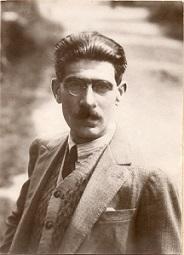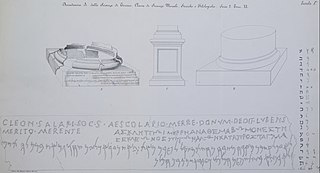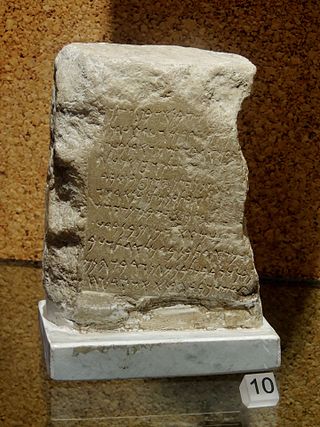
Sardinian or Sard is a Romance language spoken by the Sardinians on the Western Mediterranean island of Sardinia.

Olbia is a city and commune of 60,346 inhabitants in the Italian insular province of Sassari in northeastern Sardinia, Italy, in the historical region of Gallura. Called Olbia in the Roman age, Civita in the Middle Ages and the Terranova Pausania until the 1940s, Olbia has again been the official name of the city since the fascist period.

Sassarese is an Italo-Dalmatian language and transitional variety between Sardinian and Corsican. It is regarded as a Corso–Sardinian language because of Sassari's historic ties with Tuscany and geographical proximity to Corsica. Despite the robust Sardinian influences, it still keeps its Corsican roots, which closely relate it to Gallurese; the latter is linguistically considered a Corsican dialect despite its geographical location, although this claim is a matter of controversy. It has several similarities to the Italian language, and in particular to the old Italian dialects from Tuscany.

Carlo Fea was an Italian archaeologist.

Torres is an Italian football club based in the city of Sassari. It plays in Serie C, the third division of the Italian football league system.
Filippo Coarelli is an Italian archaeologist, Professor of Greek and Roman Antiquities at the University of Perugia.

Giorgio Levi Della Vida was an Italian Jewish linguist whose expertise lay in Hebrew, Arabic, and other Semitic languages, as well as on the history and culture of the Near East.

Frabosa Sottana is a comune (municipality) in the Province of Cuneo in the Italian region Piedmont, located about 90 kilometres (56 mi) south of Turin and about 20 kilometres (12 mi) southeast of Cuneo. The economy is based on winter tourism, based on the nearby ski resort of Prato Nevoso.
Canicattini Bagni is a comune (municipality) in the Province of Syracuse, Sicily (Italy), located about 190 kilometres (120 mi) southeast of Palermo and about 20 kilometres (12 mi) southwest of Syracuse. As of 31 December 2004, it had a population of 7,415 and an area of 15.1 square kilometres (5.8 sq mi).

The Perfect Fusion was the 1847 act of the Savoyard king Charles Albert of Sardinia which abolished the administrative differences between the mainland states and the island of Sardinia within the Kingdom of Sardinia, in a fashion similar to the Nueva Planta decrees between the Crown of Castile and the realms of the Crown of Aragon between 1707 and 1716 and the Acts of Union between Great Britain and Ireland in 1800.

The Cippi of Melqart are a pair of Phoenician marble cippi that were unearthed in Malta under undocumented circumstances and dated to the 2nd century BC. These are votive offerings to the god Melqart, and are inscribed in two languages, Ancient Greek and Phoenician, and in the two corresponding scripts, the Greek and the Phoenician alphabet. They were discovered in the late 17th century, and the identification of their inscription in a letter dated 1694 made them the first Phoenician writing to be identified and published in modern times. Because they present essentially the same text, the cippi provided the key to the modern understanding of the Phoenician language. In 1758, the French scholar Jean-Jacques Barthélémy relied on their inscription, which used 17 of the 22 letters of the Phoenician alphabet, to decipher the unknown language.
Renzo Picasso (1880–1975) was an Italian architect, engineer, and urban planner and designer.

Sessanta racconti is a 1958 short story collection by the Italian writer Dino Buzzati. The first 36 stories had been published previously, while the rest were new. Subjects covered include the horror and surreality of life in a modern city, the existential aspects of advanced technology, metaphysical ideas as well as fantasy realms. The book received the Strega Prize.

Cascina Sant'Ambrogio is the oldest among the farmhouses in Brugherio, Italy. It is annexed to Saint Ambrose Church from which it takes its name.

The Baths of the Rotonda are the remains of one of several Roman public baths in the city of Catania, Sicily. Built between the 1st and 2nd century CE, they are not far from the Roman theatre and the odeon. In the Byzantine era, the church of Santa Maria della Rotonda with its characteristic dome was built upon the remains of the Roman baths. Its walls are still covered in medieval and baroque frescoes.
Saverio De Michele was an Italian businessman and politician. He served as Mayor of Olbia from 1956 to 1963.

The Pauli Gerrei trilingual inscription is a trilingual Greek-Latin-Phoenician inscription on the base of a bronze column found in San Nicolò Gerrei in Sardinia in 1861. The stele was discovered by a notary named Michele Cappai, on the right side of the Strada statale 387 del Gerrei that descends towards Ballao.

The Giardino Birocchi inscription is a Punic inscription on a marble block with 11 lines of text found near the Chiesa della Santissima Annunziata in Cagliari in 1912. It was found in a garden belonging to Eusebio Birocchi. It is held today in the National Archaeological Museum, Cagliari.

The Tripolitania Punic inscriptions are a number of Punic language inscriptions found in the region of Tripolitania – specifically its three classical cities of Leptis Magna, Sabratha and Oea (Tripoli), with the vast majority being found in Leptis Magna. The inscriptions have been found in various periods over the last two centuries, and were catalogued by Giorgio Levi Della Vida. A subset of the inscriptions feature in all the major corpuses of Canaanite and Aramaic inscriptions, notably as KAI 119-132.
The Tharros Punic inscriptions are a group of Punic inscriptions found at the archeological site of Tharros in Sardinia.
















